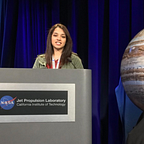Tides and the Moon
What causes tides on Earth?
The moon and the earth are gravitationally attracted to each other. The moon pulls at everything on the earth, but the earth also pulls at everything on its surface. The earth holds continents and mountains and oceans in place with its gravitational power.
But not all the time. The ocean is always sloshing about and as the earth spins, the ocean moves around, unlike mountains that are stable and rooted. That helps the moon have a little more influence over the oceans and their movement, and makes it capable of pulling at it with visible effects.
So, while the moon pulls at every part of the earth, the effect is visible only on oceans.
As the moon pulls on the water, the water rises up, causing the earth to bulge out. This bulge points towards the moon while the earth continues rotating below it. This causes high tides.
But then, high tides are caused twice a day — there are two high tides every 25 hours! The first high tide is what we saw above, the second occurs on the opposite side of the earth simultaneously. This is because as the earth rotates with that bulge pointing towards the moon, inertial forces want to keep the bulge active and pointing upwards.
That means the bulge travels with the earth, reaching its stretching limit on the opposite side of the moon and the first high tide, forming the second high tide before falling back. The net summary of this can be explained as the second bulge being caused because the moon is pulling the earth away from underneath the sea on the opposite side!
The difference in high tides and low tides, even over just a day, can be very different in different parts of the world. Since continents are massive, they come in the way of flowing water. As some places are at a higher sea level, they might see more difference in the tidal variations. Some places have very drastic visible tide movements over the course of just a day.
The above video shows a time lapse of six and a half hours: the variation in the water level between a high tide and low tide, twice a day, is dramatic. In summary, if you are on the coast and the moon is directly overhead, you will experience a high tide. If the moon is directly overhead on the opposite side of the planet, you will still experience a high tide.
Apart from the moon, the sun also plays a role in the kind of tides we have. The sun pulls water on the earth just like the earth does. While the sun’s pull by itself might not really be noticeable, combined with the moon, the high tides are substantially stronger. These stronger tides occur when the sun, moon, and earth are in a straight line, effectively having sun and the moon pull tides from the same direction, combining their forces. As the moon goes around, the tides are pulled from the opposite direction, so there are bulges formed on both sides. These are called Spring Tides and occur on either a new moon or a full moon.
When the moon is perpendicular to the line connecting the earth and the sun, neap tides occur. These happen in the first quarter and the third quarter of the moon’s phase. The sun and the moon’s pull effectively cancel each other out, so the high tides are much lower than the spring tides.
Every 2 weeks we send out a newsletter giving you an update of all that is happening at TeamIndus and opportunities for you to engage with us.
